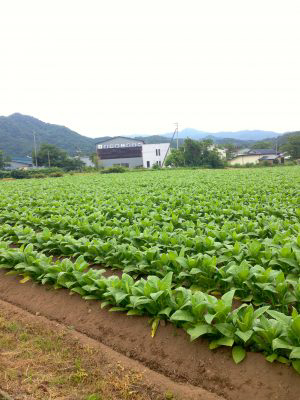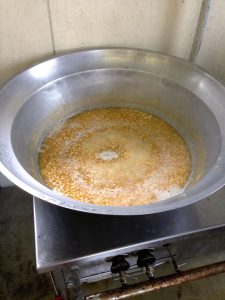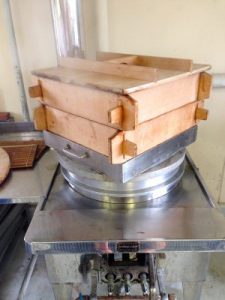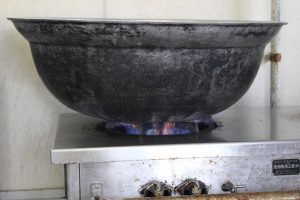We started with soybeans and mold. Yes, mold. Rather than taking the familiar approach of sterilizing, sealing, pasteurizing, and refrigerating to ensure the complete elimination of all living substances from food products, we planned on mixing fresh soybeans with ample quantities of mold. This particular mold is the secret ingredient many of the most treasured Japanese foods. From sake to soy sauce to pickles, koji, this particular rice mold, serves as a crucial component in traditional food processing. Known in the scientific community as Aspergillus oryzae, this fungus comes originally from the rice fields where it makes its home on the starchy grains.
When we arrived at a large community kitchen to participate in miso making, our host and teacher Akihiro Asami brought in two large tubs. One contained soybeans he grown in his fields. The other housed the precious koji. With the addition of 5 kilograms of salt and the final ingredient of time, this would be all we needed to produce enough miso for Asami-San’s family for two years.
Asami-San began to miso-making process two days before by cultivating enough koji for the miso. It took those two days of carefully ensuring the temperature stayed just right for the white mold to thrive while it grew on the rice. We had the chance to taste the finished culture. The intact rice it grew on made it a little chewy and it tasted faintly sweet, but not at all unpleasant. Yet the magic of koji lies not in what it is on its own, but in the transformation it causes when mixed with a few other ingredients and time.
- Soybeans boiling away
- Steaming soy beans
First, under Asami-San’s instruction we began to prepare the all-important soybeans. He developed his technique with a combination of tradition and practice. We put half of the soybeans into a two-layer steamer. Since steam rather than direct contact with hot water cooks the bean with this method, they retain more of their flavor and give the miso more depth. However, steaming also results in a final bean-mash that is too dry to make good miso. So we boiled the other half of the soybeans. These beans would inevitably leach some of their flavor into the water they cooked in, but the moisture retained with this cooking method was important to final product. The combination of both methods and the balance between them held the key to delicious miso.
As the soybeans began to cook, a sweet smell reminiscent of maple syrup filled the kitchen. Those crucial sugars locked up in each individual soybean would eventually feed the koji culture and spur a transformation into the iconic salty-umami flavor of miso. But for now they needed time to fully cook, one cannot rush good food. So, we took the chance to explore the surrounding areas while the soybeans boiled and steamed away.
 Flowers fill the landscape of Kitakata and the surrounding areas in June. Lining fields of vegetables (some I could identify and others I couldn’t) and springing up in gardens, fields, and window boxes various colored blooms brought variety to the deep green vegetation that filled much of the area. We walked along the nearby roads, through a public garden, and between the houses. Late in the morning on a weekday, peaceful quiet filled the streets. We were alone, save for a few locals who smiled and greeted as when we passed. After our walk and lunch at a local ramen shop, the soybeans softened enough for the next step.
Flowers fill the landscape of Kitakata and the surrounding areas in June. Lining fields of vegetables (some I could identify and others I couldn’t) and springing up in gardens, fields, and window boxes various colored blooms brought variety to the deep green vegetation that filled much of the area. We walked along the nearby roads, through a public garden, and between the houses. Late in the morning on a weekday, peaceful quiet filled the streets. We were alone, save for a few locals who smiled and greeted as when we passed. After our walk and lunch at a local ramen shop, the soybeans softened enough for the next step.
Like any good cook, we tasted at each step along the way. The difference between the boiled and steamed soybeans was evident in their sweetness. The steamed beans retained more sugar and had a richer flavor, while the boiled beans turned out milder and less sweet. Now with cooked soybeans and ready to begin the more active steps of miso-making, Asami-San opened the large center table in the kitchen, which provided a large walled area for mixing our miso. We split of the teams, one to prepare the koji and one to prepare the soybeans.
The koji team was responsible for mixing five kilograms of salt evenly into a pile of our precious rice mold. The best method involves rolling up your sleeves, dumping everything onto the table, and using your hands to break up chunks of koji and mix in the salt. Thoroughness is rewarded in miso making and patience required, and we took our time to ensure the salt and koji were well combined. Ever curious, I tasted the mix. It retained the sweetness of the koji, but now was also aggressively salty.
- Making miso is a team effort
- Heat, soybeans, koji, water, and time: the ingredients for miso
The soybean team had the task of putting the cooked beans through a meat grinder to produce a mash. They began with the steamed beans, which went through the machine fairly easily. We spread the bean mash on the table separate from the koji to cool. Keeping the two separate was crucial, since the heat of the beans could kill the all-important koji and ruin any chance at producing miso. The boiled beans posed more of a challenge. Their wetter consistency had a tendency to clog the meat grinder, and we ended up mashing some of them by hand with a potato masher instead. Once we mashed and cooled the soy beans, we all gathered around the table to mix everything together. Using just our hands, we kneaded, turned, and mixed the salted koji and ground soybeans together. Asami-San watched with a trained eye to ensure the final mix retained the proper amount of moisture, adding some of the water used to boil the soybeans when he thought it got too dry. Again, thorough mixing was the key to success. The final mix had the consistency of biscuit dough with visible grains of rice from the koji. It tasted salty with the savory flavor of the soybeans and a hint of sweetness.
Finally, the mixed needed to be packed into bins where it would ferment for six months before being ready to eat. Air is the enemy of the anaerobic fermentation needed to make miso, so the bins had to be as tightly packed as possible. Asami-San had a particular technique to ensure we eliminated as much air as possible. First, we packed the soybean-koji mix into balls about the size of softballs. This is where practice from childhood snowball fights comes in handy, ensuring each ball was as firmly packed as possible. Then, one at a time, we firmly threw each ball into one of two bins where they flattened with the force of impact. The trickiest part of this technique was ensuring that some of the balls got thrown along the edges of the bin. We needed careful aim to ensure the mix packed in against the side without accidentally throwing it onto the floor next to the bin instead. All of our throws, except for one sad ball of wasted koji and soybeans that ended up on the floor instead of in the bin, contributed to two tightly packed bins of soon-to-be miso.
Once home, Asami-San planned to cover our mix with a layer of last year’s miso to prevent any contact with air and allow it to sit for 6 months while the koji did its magic. After 6 months, out of three simple ingredients he would have miso. This technique for producing a complex and delicious food from time and traditional ingredients has been practiced in Japan for thousands of years. In a time of industrial food processing, homemade miso is increasingly rare. However, by taking part in the time consuming yet rewarding process of making miso, we had the chance to learn about and connect to an important traditional food product. We also had the privilege of working with fresh, organic products that Asami-San grew himself. The rice in the koji and soybeans came from Asami-San’s fields where he practices organic agriculture. From the soil around us and our own patience and work, we produced enough miso for Asami-San’s family for two years.
After cleaning up the kitchen, we headed next door to the local onsen. After all, not day of work is complete without a long soak in the hot springs




Recent Comments